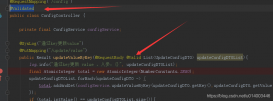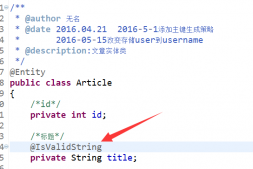先看下JDK中的说明:
|
1
2
3
4
5
6
7
8
9
10
11
12
13
14
15
16
17
18
19
20
21
22
23
24
25
26
27
28
29
|
java.lang.Object java.lang.Class<T> Instances of the class Class represent classes and interfaces in a running Java application. An enum is a kind of class and an annotation is a kind of interface. Every array also belongs to a class that is reflected as a Class object that is shared by all arrays with the same element type and number of dimensions. The primitive Java types (boolean, byte, char, short, int, long, float, and double), and the keyword void are also represented as Class objects.Class has no public constructor. Instead Class objects are constructed automatically by the Java Virtual Machine as classes are loaded and by calls to the defineClass method in the class loader.The following example uses a Class object to print the class name of an object: void printClassName(Object obj) { System.out.println("The class of " + obj + " is " + obj.getClass().getName()); } It is also possible to get the Class object for a named type (or for void) using a class literal. System.out.println("The name of class Foo is: "+Foo.class.getName());在一个运行着的JAVA应用中,类的任何实例都可以用Class对象来指代,Class可以指代所有的类和接口。枚举属于类,注解属于接口,均可以用Class指代。每个数组均属于反射的Class对象,数组中的每个元素和维度也同样拥有Class对象。Java基本类型(boolean, byte, char, short, int, long, float, and double)以及关键字void也都可以用Class指代。Class类不存在构造函数,当类被加载过程中由JVM通过调用类加载器中的defineClass方法自动构造。下面的例子是将一个对象通过Class对象打印出类名。 void printClassName(Object obj) { System.out.println("The class of " + obj + " is " + obj.getClass().getName()); }通过class关键字指定类型也是可以得到Class对象的 System.out.println("The name of class Foo is: "+Foo.class.getName()); |
上面内容总结下,就是Java中所有的对象以及基本类型都是可以用Class指代的。接下来看一个Demo。
|
1
2
3
4
5
6
7
8
9
10
11
12
13
14
15
16
17
18
19
20
21
22
23
24
25
26
27
28
29
30
31
32
33
34
35
36
37
38
39
40
41
42
43
44
45
46
47
48
49
50
51
52
53
54
55
56
57
58
59
60
61
62
63
64
65
66
67
68
69
70
71
72
73
74
75
76
77
78
|
/** * * 旨在测试Class对象和Instance之间的关系; * @author zzy * */public class ObjClass { private enum tmpEnum {A, B, C}; public static void main(String[] args){ int[] tmpArray = {1,2,3}; Class classType; try { // 通过类名直接获取Class对象,JVM中没有加载。 classType = InClass.class; System.out.println(".class: " + classType); System.out.println(".class finish."); // Java加载类 classType = Class.forName("InClass"); System.out.println("Class.forName: " + classType); System.out.println("Class.forName: finish."); // 创建实例 InClass newClassType = new InClass(); classType = newClassType.getClass(); System.out.println("new Object.getClass: " + classType); System.out.println("new Object.getClass: finish."); // 数组对象 classType = tmpArray.getClass(); System.out.println("Array.getClass:" + classType.getSimpleName()); System.out.println("Array.getClass: finish."); // 枚举对象 classType = tmpEnum.class; System.out.println("enum.class:" + classType); System.out.println("enum.class: finish."); } catch (ClassNotFoundException e) { // TODO Auto-generated catch block e.printStackTrace(); } } }class InClass{ // 对静态变量声明之前赋值 { staticPara = 10; } public static int staticPara; // 构造函数 public InClass(){ System.out.println("construction..."); } // 静态代码块 static { System.out.println("static function..."); } // 静态变量赋值 { staticPara = 20; } { System.out.println("normal function, staticPara:" + staticPara); } // 静态变量赋值 { staticPara = 30; } } |
输出结果:
|
1
2
3
4
5
6
7
8
9
10
11
12
13
|
.class: class InClass.class finish.static function...Class.forName: class InClassClass.forName: finish.normal function, staticPara:20construction...new Object.getClass: class InClassnew Object.getClass: finish.Array.getClass:int[]Array.getClass: finish.enum.class:class ObjClass$tmpEnumenum.class: finish. |
说明:
1. .class方式获取类文件的Class对象,并不需要加载JVM中。
2. Class.forName的方式JVM会加载类,同时会编译。 如此,类中的静态代码块就会被执行。
3. 创建实例过程中(已经加载至JVM中,也就是说编译过了),调用构造函数,并执行非静态代码块。
4. 静态代码对于变量的声明和赋值顺序是没有影响的(编译过程处理),所以结果是20。
5. 数据对象和枚举对象也是可以被Class对象指定的。
以上这篇基于Java class对象说明、Java 静态变量声明和赋值说明(详解)就是小编分享给大家的全部内容了,希望能给大家一个参考,也希望大家多多支持服务器之家。















